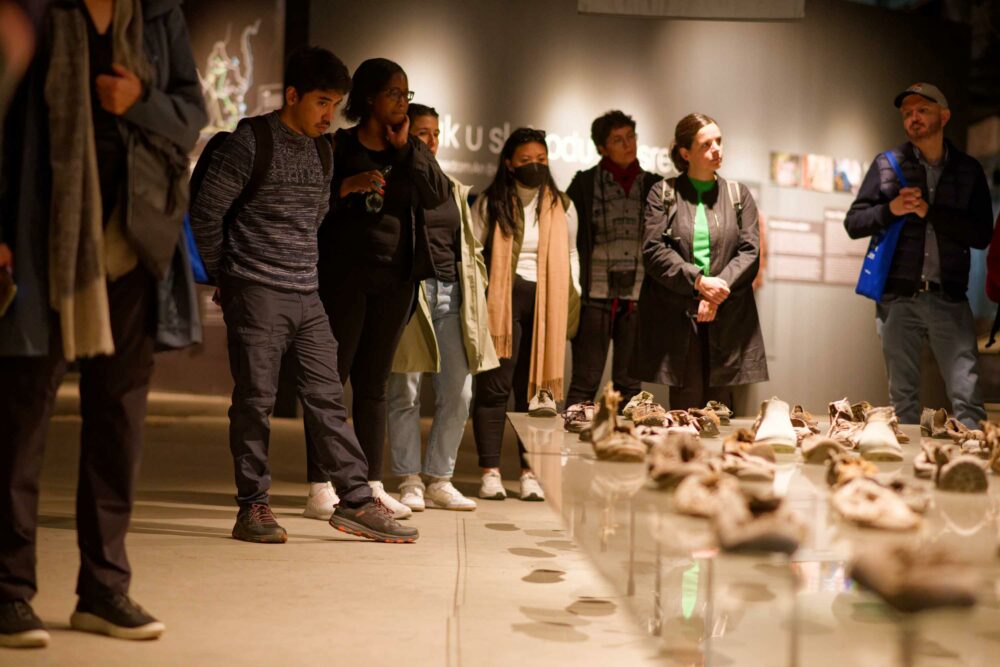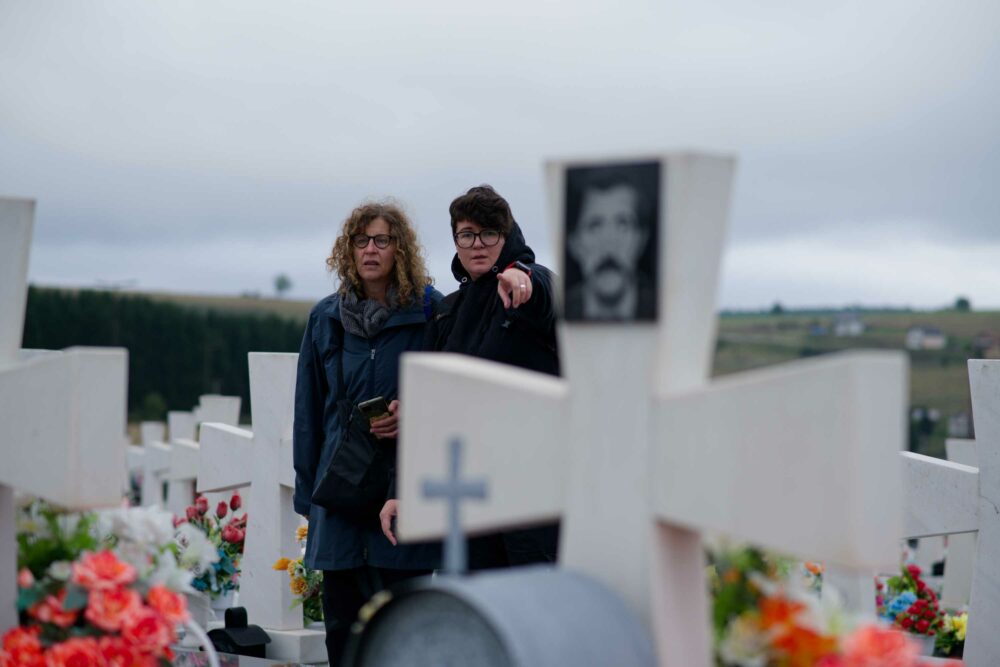Bosnia and Herzegovina, 23-28.9.2023.
The point at which people start naming things and explaining them with terms, when they start redefining terms and giving them entirely new meanings in different interpretations of the world, ranging from the philosophical to the spiritual, this is, in fact, when they magically make the leap into civilisation. In Christianity, this moment is marked by the word (“In the beginning was the Word”), in Islam, what distinguishes the first man from the angels is his ability to name things, logos is one of the key terms used by Greek philosophers… We begin learning terms from a very young age, everything around us is harnessed to teach us myriad terms and their meanings. Later in life, our choice of profession often boils down to choosing the field in which we will learn more terms and how to use them better than others…
Although each generation adds new terms to this universal glossary and redefines or outright rejects old ones, it is plain that we actually adopt and later use most terms as given. Only children will dare ask a supremely logical question such as: Why is it Monday today? Why can’t it be Saturday?
The Global Learning Hub for Transitional Justice and Reconciliation was founded at the end of last year with the idea of exchanging experience and learning together. Its network comprises governmental and non-governmental organisations from Germany (Federal Foundation for the Study of the Communist Dictatorship in Eastern Germany; Foundation Remembrance, Responsibility and Future EVZ Foundation; Working Group on Peace and Development FriEnt, Berghof Foundation), international/regional organisations (Impunity Watch; Asia Justice and Rights, Centre for Nonviolent Action Sarajevo-Belgrade), as well as organisations from various countries (Dejusticia from Colombia, Centre for the Study of Violence and Reconciliation from South Africa).
When we decided to organise a study trip for organisations of this global network that had come together in another term that is impossible to translate into our language without sounding silly, we wanted to go the other way: Instead of us encountering terms, we wanted to see what would happen if terms were to encounter some people and some places. Since both transitional justice and reconciliation are terms made up of other terms, assembled together like Lego blocks, we wanted to take justice, reconciliation, truth, victims, perpetrators, pain, reparations, shame, memory, compassion, righteousness and many other terms and go to people and places to see what would happen. How does memory function in postwar Bosnian-Herzegovinian society, what does justice mean, how are genocide victims and other victims commemorated, is there a hierarchy of victims and what does it imply, should military casualties be remembered in the context of transitional justice and peacebuilding, and how, what do survivors and families of victims identify as their needs and what does the term reparation mean to them, can anyone stand before us and guarantee with certainty never again…
Some places and some (special) people
On the first day, we visited the Srebrenica Memorial Centre in Potočari where we took in the permanent exhibition dedicated to the genocide victims, titled “In the footsteps of those who did (not) cross”, and the cemetery, and on our way back we briefly stopped at the memorial for Serb victims in Kravice near Bratunac and the military memorial cemetery Mali zejtinlik (recently renamed Novi zejtinlik) in Sokolac. On the second day, we visited the Vraca Memorial Park, the impressive (and impressively neglected) complex dedicated to military and civilian victims from the Second World War, and then we went to the Sveti Sava Primary School in East Sarajevo where we visited the monument erected in the school yard to commemorate the killed children of Serb Sarajevo. In the afternoon of the second day, we visited Ahmići near Vitez and the memorial commemorating 116 Bosniak civilians who were killed there on 16 April 1993, as well as the “Osmica” memorial in memory of eight Croat children killed in June 1993. On the third day, we visited urban areas in Sarajevo and key sites of memory such as the Suada and Olga Bridge, the Sarajevo Roses, the Memorial to Children Killed in the Siege of Sarajevo, Ferhadija, Markale, etc.
More than the places themselves, it was important for us to meet with people and talk with them. Our guide at the Memorial Centre was Azir Osmanović, a historian, curator, and surviving witness of the genocide, and we spent two hours in conversation with him. What sort of support do victims need, what are his family’s experiences with the absence of such support, who is the Memorial Centre for, who are the usual visitors, what kinds of questions do they ask, these were just some of the many topics we managed to at least broach during those two hours. Our curator and guide at Novi zejtinlik was the historian Tomislav Tamburić, while in East Sarajevo, we were greeted by Željka Topalić, the headmistress of the school behind the initiative for the monument to children killed in Serb Sarajevo, who briefly explained the context and why the monument was erected. For two days, we were also in the company of our longstanding friend and associate Adnan Hasanbegović. A war veteran and long-time activist, our Ado is an inexhaustible source of stories, a walking (historical) narrative, someone who gives every term either a new perspective or incorporates it into a witty remark or joke…
In Vitez, we were joined by Dragica Tomić from Trusina near Konjic. We wanted to find some way to tell the story of Ahmići and Trusina, so after our visit to Ahmići, and because we were unable to also visit Herzegovina, it seemed the best thing to do would be to talk to someone from Trusina. We would have never presumed to ask this of Dragica, but because of the kind of person she is, she insisted on coming with us to visit Ahmići and lay a rose in memory of the victims killed there on the same day as her loved ones were killed in Trusina. After we visited both Trusina and Ahmići with a mixed group of war veterans in the course of two years, I kept having this vision of an encounter between Ahmići and Trusina. They did not meet half-way, instead Trusina came to Ahmići, and we saw in the flesh the meaning of forgiveness, courage, shared memory, shame, pride, patience… There are people who are bigger than any place, city, country… Dragica is one such person. We are also grateful to Mahir ef. Husić, the imam from Ahmići whose door (and heart) is always open to us and who himself had made the journey to Trusina once. In Vitez, we also met the Garić family whose two children were killed at Osmica, barely ten meters from their doorstep, while their son Ivan, who takes care of the memorial today, was gravely wounded. When I think back to that brief conversation we had with a mother who lost two children, I see happiness and contentment (is there room for happiness in transitional justice and reconciliation?) on her face because the whole world had come to visit Osmica. We also talked about what it meant for the family that no one has been prosecuted for this crime. It would be important for them, of course, but as a mother, she is happy to see people come and visit, it means a lot to her. The name is a sign, says the Latin proverb. Her name, Mira, means peace.
We devoted one whole afternoon to talking with war veterans and long-time peace activists, our friends Amer Delić, Đoko Pupčević and Krešo Primorac. Why did they meet with former enemies, how do they handle the pressures and accusations of betrayal and betraying the unity of their people because they went to pay their respects to former enemies, how do they cope with the feeling of being responsible for the war, how do they view celebrations of wartime victories, are there any victors in war, do they view themselves, because some of them have been left with disabilities by the war, as perpetrators or victims, what is it like to visit places where their side committed the crimes, what makes them go anyway and take up that burden… We often discuss all these issues with war veterans, these are the questions that we always open and that are significant for us, but this time the conversation was particularly emotional and rich in detail. We are also grateful to Đoko’s wife Milka who joined us and provided a new dimension to the conversation.
A community in agreement
After the three days of the study trip, we continued our discussions of many terms over the next two days through various workshops. We wanted to completely unpack the Lego structure of terms and examine the blocks individually and how they are assembled in the Balkans, in Indonesia, South Africa or Colombia, we wanted to see if after all these experiences, we could imagine putting them together differently, making them fit together better? When kids play with Lego blocks, some like to start from scratch. Others fear taking apart something that has already been put together. No matter how ill-fitting.
Since the Global Learning Hub for Transitional Justice and Reconciliation aims to network and build partnerships, it was important for us to open up space for conversations not just about how we understand the same terms, but also about what our organisations are currently doing and how we would like to work together. There is a joke about there always being regrets in a partnership (originally: marriage): In the case of bad partnerships, there is regret over having entered into them at all, and in the case of good partnerships, there is regret over not having done so sooner. Since we see partnerships as communities in agreement, it was fundamentally important for us to open up spaces for that agreement and community building, which is the shared responsibility of everyone involved in the process. However our little community continues to develop in the future, we are endlessly grateful that we have been caught in this net and been able to host people from South Africa, Lebanon, Colombia, Indonesia and Germany. Questions, comments, friendship, disagreements and different views, and sometimes just a shared silence, all of it enriched us immensely. Thank you, dear friends.
The photo gallery is available HERE

